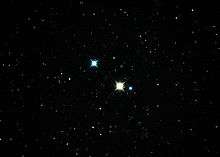30 Cygni
| Observation data Epoch J2000 Equinox J2000 | |
|---|---|
| Constellation | Cygnus |
| Right ascension | 20h 13m 18.05358s[1] |
| Declination | 46° 48′ 56.4424″[1] |
| Apparent magnitude (V) | 4.83[2] (4.81 - 4.84[3]) |
| Characteristics | |
| Spectral type | A5IIIn[4] |
| U−B color index | +0.17[2] |
| B−V color index | +0.10[2] |
| Variable type | suspected[3] |
| Astrometry | |
| Radial velocity (Rv) | -26.00[5] km/s |
| Proper motion (μ) | RA: +13.83[1] mas/yr Dec.: +3.00[1] mas/yr |
| Parallax (π) | 5.34 ± 0.33[1] mas |
| Distance | 610 ± 40 ly (190 ± 10 pc) |
| Details | |
| Radius | 1.40[6] R☉ |
| Luminosity | 323.56[7] L☉ |
| Temperature | 7,712[7] K |
| Rotational velocity (v sin i) | 145[8] km/s |
| Other designations | |
| Database references | |
| SIMBAD | data |

30 Cygni at top left, with 31 Cygni A and B at lower right
30 Cygni is a class A5III (white giant) star in the constellation Cygnus. Its apparent magnitude is 4.83 and it is approximately 610 light years away based on parallax.
The Bayer letter ο (omicron) has been variously applied to two or three of the stars 30, 31, and 32 Cygni. 30 Cygni has sometimes been designated as ο1 Cygni with the other two stars being ο2 and ο3 respectively. For clarity, it is preferred to use the Flamsteed designation 30 Cygni rather than one of the Bayer designations.[9]
30 Cygni is about six arc-minutes from 31 Cygni A and seven arc-minutes from 31 Cygni B. That pair is known as ο1 Cygni, while ο2 Cygni is a degree away. Both ο1 and ο2 are 4th magnitude stars.
References
- 1 2 3 4 5 van Leeuwen, F. (2007). "Validation of the new Hipparcos reduction". Astronomy and Astrophysics. 474 (2): 653–664. arXiv:0708.1752. Bibcode:2007A&A...474..653V. doi:10.1051/0004-6361:20078357. Vizier catalog entry
- 1 2 3 Mermilliod, J.-C. (1986). "Compilation of Eggen's UBV data, transformed to UBV (unpublished)". Catalogue of Eggen's UBV data. Bibcode:1986EgUBV........0M.
- 1 2 Samus, N. N.; Durlevich, O. V.; et al. (2009). "VizieR Online Data Catalog: General Catalogue of Variable Stars (Samus+ 2007-2013)". VizieR On-line Data Catalog: B/gcvs. Originally published in: 2009yCat....102025S. 1. Bibcode:2009yCat....102025S.
- ↑ Jaschek, M. (July 1978), "Catalogue of selected spectral types in the MK system", Bulletin d'Information du Centre de Donnees Stellaires, 15 (121): 121, Bibcode:1978BICDS..15..121J Vizier catalog entry
- ↑ Kharchenko, N. V.; et al. (2007), "Astrophysical supplements to the ASCC-2.5: Ia. Radial velocities of ˜55000 stars and mean radial velocities of 516 Galactic open clusters and associations", Astronomische Nachrichten, 328 (9): 889, arXiv:0705.0878, Bibcode:2007AN....328..889K, doi:10.1002/asna.200710776
- ↑ Pasinetti Fracassini, L. E.; Pastori, L.; Covino, S.; Pozzi, A. (February 2001), "Catalogue of Apparent Diameters and Absolute Radii of Stars (CADARS) - Third edition", Astronomy and Astrophysics, 367 (2): 521–524, arXiv:astro-ph/0012289, Bibcode:2001A&A...367..521P, doi:10.1051/0004-6361:20000451 Vizier catalog entry
- 1 2 McDonald, I.; Zijlstra, A. A.; Boyer, M. L. (2012). "Fundamental parameters and infrared excesses of Hipparcos stars". Monthly Notices of the Royal Astronomical Society. 427: 343. arXiv:1208.2037. Bibcode:2012MNRAS.427..343M. doi:10.1111/j.1365-2966.2012.21873.x.
- ↑ Van Belle, Gerard T. (2012). "Interferometric observations of rapidly rotating stars". The Astronomy and Astrophysics Review. 20: 51. arXiv:1204.2572. Bibcode:2012A&ARv..20...51V. doi:10.1007/s00159-012-0051-2.
- 1 2 Kostjuk, N. D. (2004). "VizieR Online Data Catalog: HD-DM-GC-HR-HIP-Bayer-Flamsteed Cross Index (Kostjuk, 2002)". VizieR On-line Data Catalog: IV/27A. Originally published in: Institute of Astronomy of Russian Academy of Sciences (2002). 4027. Bibcode:2004yCat.4027....0K.
This article is issued from
Wikipedia.
The text is licensed under Creative Commons - Attribution - Sharealike.
Additional terms may apply for the media files.